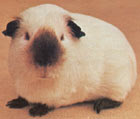Recently,
I got a new pet, a sweet little guinea pig, and I named her Bailey.
No one
really knows why or how Guinea Pigs got their name because they are neither
pigs nor do they originate from Guinea.
They are cavies and come from South America. Cavies are any of the
various South American rodents of the caviidae family. The name guinea pig dates back to the 17th
century. The first record of
it (as ginny-pig) is in William Harvey’s medical textbook Anatomical
exercitations, concerning the generation of living creatures, 1653.
There are many variations of coat and color - This is a smooth coated Himalayan variety
There are
many different breeds of Guinea Pigs and a variety of color variations. If you go and visit your local pet
store, you can see many of these different variations for yourself.
Guinea
Pigs that live in the wild will usually stay in herds
that consist of one adult male, several females and their babies. Herd animals like to stay together so
that way they have a much better chance to see and avoid danger that is coming
their way. Guinea Pigs have no
real self defense mechanisms, so herding is essential. As in the wild, domestic Guinea Pigs
enjoy having the company of their own kind. Some form very close relationships, others may not, but most
appear to be happy when they know that they’re not alone.
There are
many types of bedding to use in cages, but some may be harmful to your pet. To
help conserve bedding, you can use several layers of newspaper. It’s absorbent,
helps with warmth, and also makes cage cleaning faster and easier. Kiln-dried pine shavings and aspen
shavings are some of the best bedding to use. Never use cedar shavings or sawdust. Using bedding like these that have very
small particles are very bad for small animals due to the fact that they are
easily inhaled.
The long flowing coat identifies this one as a Peruvian (sometimes called Silky) pig
To keep a
guinea pig stimulated and happy while in their cage you should have a cage big
enough to have hidey houses and tubes.
Don’t overcrowd the cage though, since they do need room to move freely. The houses and tubes make them feel
secure and comfortable. To prevent boredom change these things out regularly.
Guinea
Pigs have very delicate bodies so you must be careful when handling them. When picking up a guinea pig approach
them from the front rather then from behind because they may become very
frightened when they are suddenly lifted and don’t see it coming. Place one hand under their belly just
behind their front legs and use the other hand to support their hindquarters. Definitely be careful not to squeeze
them because their organs are very fragile. It is a good idea to only hold your guinea pig for about ten
minutes at a time. They will
naturally want to go to the bathroom and if you handle them too long, they will
poop on you.
Reeces, a former WBS resident, was an Abyssinian variety
Before
getting a guinea pig as a pet make sure you do your research about their
diet. There are many things that
guinea pigs can have to eat. One
such food is timothy hay and another one is mixed grass hay. Mixed grass hay should be available in
unlimited amounts due to how good it is for your pig. Alfalfa is higher in calories, lower in fiber, and is not
quite as good for them, so it is not a preferred source of nutrition. Most fruits and vegetables are fine for
them as long as it is in moderation.
Kale is another form of nutrition for them, but it should only be fed
once a week. Apples are very
nutritional and can be fed once a day in moderate quantities. Guinea Pigs should get three servings
of fruits and vegetables a day, but no more then one serving of any single vegetable.
One of the three servings should be a leafy green vegetable.
Another former WBS resident Guinea Pig - Inca
Guinea
Pigs share a unique quality with humans; they must have vitamin C for their
bodies. Since they cannot normally
produce vitamin C, it must be supplied in food or supplements. Guinea Pigs that don’t get adequate
amounts of vitamin C can develop a disease that in humans is called
scurvy. Vitamin C deficiencies in
guinea pigs can be determined by loss of appetite, bleeding from gums, joint
stiffness, weight loss and poor tooth development. Feeding guinea pigs a diet that is high in vitamin C is very
important. Leafy greens such as:
kale, spinach, cabbage, red and green peppers, asparagus, broccoli, peas,
tomatoes, dandelion greens (no pesticides, fertilizers or herbicides), kiwi and
oranges are all great sources of vitamin C. Note however, that some of these such as kale, (which stated
above can only be given once a week), cannot be given all the time, so you must
remember the appropriate times to give them which type of vitamin C source.
There are
many things to know about Guinea Pigs before getting one as a pet. The same
goes with any animal that you think you might want as a pet. Always do your
research before you take on the responsibilities and duties of pet ownership.
Submitted
by Jamie Sansoucie, World Bird Sanctuary Naturalist





No comments:
Post a Comment